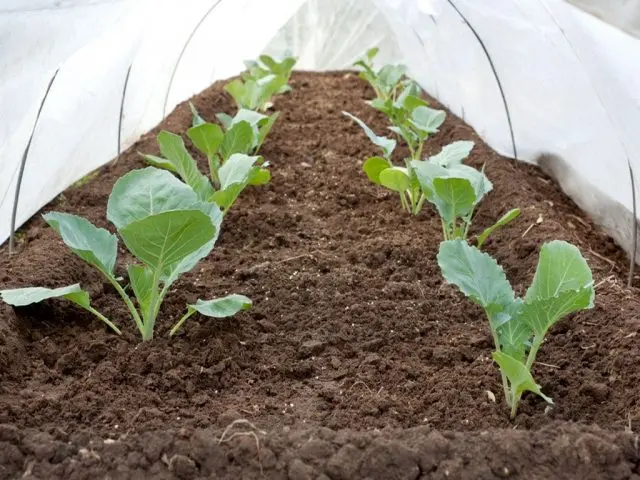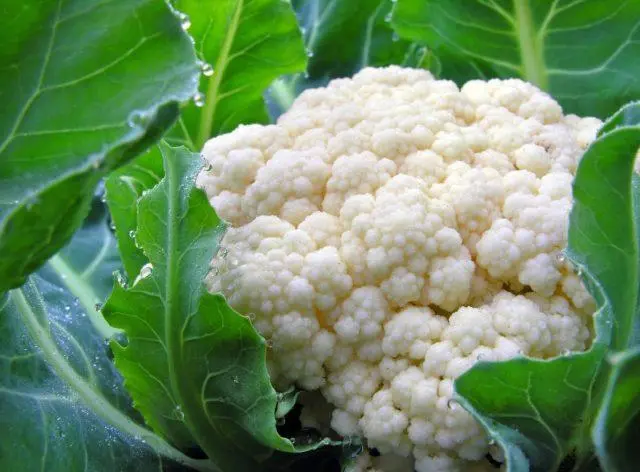Contents
It is quite possible to plant cauliflower in a greenhouse. As a rule, it is grown in seedlings, but direct sowing of seeds in the ground is also allowed. Work should begin at the end of March, and transferred to the greenhouse at the beginning of May. Plants need cool and moist conditions. Periodically they are watered and fertilized.
Is it possible to grow cauliflower in a greenhouse
It is easier to grow a crop in a greenhouse than in open ground. This culture is especially demanding compared to other varieties. In open ground, it is difficult to provide the desired temperature and humidity. In a greenhouse, it’s much easier:
- optimally 18-20 degrees (above +25 is undesirable);
- air humidity at 80% or slightly higher;
- lighting diffused, constant, from 14 hours a day;
- the soil is fertile, loose.
Varieties of cauliflower for greenhouses
For growing cauliflower in a greenhouse made of polycarbonate and other materials, it is recommended to choose the following varieties:
- Koza-Dereza;
- Regent;
- Alpha;
- Autumn giant;
- White castle;
- Express;
- Patriotic;
- A blizzard.
They adapt well to different climatic conditions, so you can grow such crops in almost any region. It is also worth considering that medium-late and late varieties are suitable for cultivation in a greenhouse. Early varieties of cauliflower are best grown outdoors. Since they ripen quickly, direct sowing by seeds without a seedling stage is allowed.
How to grow cauliflower in a greenhouse
Cabbage can be grown by direct sowing of seeds in the ground or by seedlings. The latter option is more time consuming, but reliable. In some regions of Our Country, return frosts are often observed in spring. And if in the south of the country the seeds can be safely sown directly into the ground, then in other areas it is not worth the risk. First you need to get seedlings, and then transfer them to the greenhouse.
Seeding for seedlings
To properly grow cauliflower in a greenhouse, you need to plant seeds for seedlings. You can start work at the same time as in the case of white varieties. Specific planting dates depend on the variety:
- the early ones are sown throughout March;
- mid-season – from March 28 to April 20;
- late – during the first and second decade of April.

Seedlings are grown at a temperature not higher than +15
Seeds are planted in common boxes, cassettes or peat tablets. The soil should be loose and fertile, for example, a mixture of soddy soil with humus, peat and sand in a ratio of 2:1:1:1. To properly grow seedlings, after sowing, it is necessary to cover with a film and put on the windowsill.
After the emergence of seedlings, the temperature is reduced to 10. As soon as two leaves appear, they dive into the container. Then you can grow already at +15, but not higher. Two weeks before transplanting, seedlings are periodically taken out to the street or to the balcony.
Transfer to a greenhouse
If cauliflower seedlings are transferred to open ground in the first half of May, then this can be done in the greenhouse at the end of April or on the May holidays. The culture needs cool conditions – the temperature is not more than +15 degrees. If it is not possible to provide it at home, the seedling boxes are transferred to the greenhouse even earlier. By the time of transplantation, each seedling should have at least three true leaves.
When planting cauliflower in a greenhouse, they act like this:
- Prepare the soil in advance – clean, dig and fertilize.
- Water seedling containers the day before transplanting.
- To grow properly in a greenhouse, holes are planned according to the 50×30 cm pattern (at least 50 cm between rows and at least 30 cm between plants).
- The seedlings are carefully taken out by transshipment in order to maintain the maximum volume of the earthy clod on the roots.
- Transplant into holes, deepening to the first leaf.
- Fall asleep and compact the soil a little.
- Then water and mulch with straw, hay, freshly cut grass or other materials.
Caring for cauliflower in a greenhouse
To grow cauliflower in a greenhouse and get a good harvest, you need to organize a fairly good care for it. Plants need regular watering, fertilization, disease prevention. The basic rules of agricultural technology are described in the following sections.
Lighting
If you grow cauliflower in a greenhouse, keep in mind that it needs a long daylight hours. In April and May, the duration exceeds 14-15 hours, which is quite enough. But at the seedling stage, it is important to highlight with phytolamps or LEDs. They are installed at a height of 50 cm and turned on for several hours in the morning and evening. It is necessary to provide daylight hours of at least 14 hours.

Cauliflower in a greenhouse does not need additional lighting
Watering
If you grow cauliflower in a greenhouse, it is also worth constantly watering it. The plant is moisture-loving, so watering should be regular. Water is given twice a week in small volumes. If the soil does not have time to dry out, the frequency is reduced. During the period of inflorescence formation, cabbage needs enhanced watering, and immediately after that it can be reduced to once a week (if there is no drought).
The water is pre-defended so that it is at room temperature or slightly warmer. Cauliflower also needs high humidity – about 80%. Therefore, most of the time the greenhouse is kept closed, although the room must be constantly ventilated.
Additional fertilizing
When they start growing cauliflower in a greenhouse, they especially think about top dressing. Fertilizers are applied several times per season:
- After planting seedlings in the ground – after about 10 days.
- 10 days after the first.
- During the formation of inflorescences.
For the first time, water under the root with mullein infusion 1:10. You can start preparing it immediately after transplanting into the ground, since it will take at least 10 days.
After 1,5 weeks, a complex composition is added (the amount is given per 10 l):
- ammonium nitrate – 30 g;
- superphosphate – 40 g;
- potassium chloride – 2 g;
- boric acid – 2 g.
Instead, you can use ready-made complex fertilizers, for example, Kemira, Baikal, Agricola.
In order to successfully grow cauliflower in a greenhouse and get a good harvest, it is necessary to make a third dressing directly during the formation of heads. To do this, use the following components (per 10 liters of water):
- ammonium nitrate – 30 g;
- calcium chloride – 20 g;
- superphosphate – 30 g.

At the stage of formation of inflorescences, it is necessary to strengthen watering and top dressing.
Protection against diseases and pests
In order to successfully grow cauliflower in a greenhouse and get a good harvest, you should also take care of the prevention of diseases and pests. Cabbage can suffer from fungal, bacterial and viral infections. These are mainly black leg, white and gray rot, mosaic, bacteriosis and others.
For prevention, seedlings after transplantation are treated with any effective fungicide:
- “Bordeaux liquid”;
- “RAW”;
- “Ridomil Gold”;
- “Tatu”.
Growing cauliflower in a greenhouse is not that difficult, but even here it can be attacked by pests such as cabbage aphids and flies, caterpillars, cruciferous fleas. To combat them, insecticides are used:
- “Fitoverm”;
- “Vertimek”;
- “Inta-Vir”;
- “Karate”.
Often there is an invasion of slugs. For prevention, approaches to the greenhouse and beds are recommended to be sprinkled with mustard powder, nut or egg shells. You can also use red hot pepper powder.
Harvest
If you grow a crop in a greenhouse correctly, you need to harvest it on time. The ripening time depends on the variety and ranges from 90 to 150 days (the countdown is from the moment of mass germination).
Heads are harvested by hand. First, the bushes are dug up along with the root and transferred to a cellar or basement for long-term storage. Then a small layer of soil is poured over the plant. But if the heads are supposed to be used immediately or, for example, sent to the workpiece, they are cut off after harvesting.
Conclusion
Planting cauliflower in a greenhouse is not very difficult. Since there is not enough space in the greenhouse, seedlings are planted at a minimum distance of 30 cm in a checkerboard pattern. The heads are grown until the heads are fully ripe, after which they are harvested and sent for storage or freezing.









